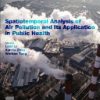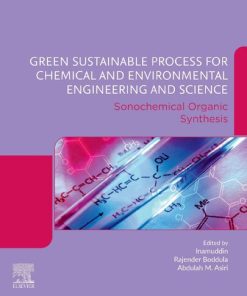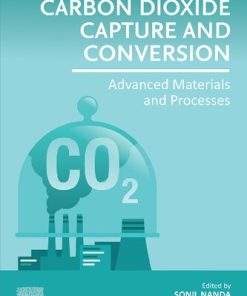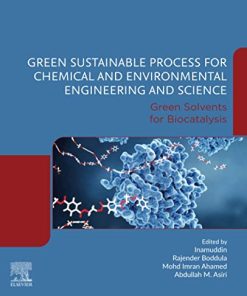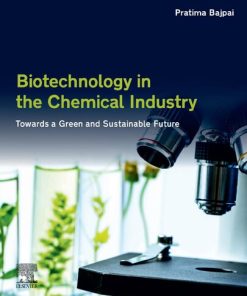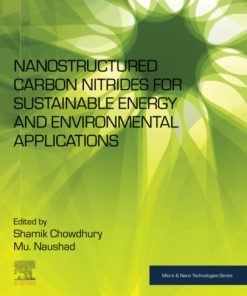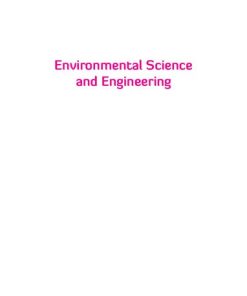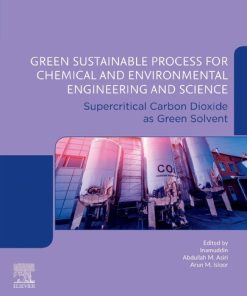Green Sustainable Process for Chemical and Environmental Engineering and Science Carbon Dioxide Capture and Utilization 1st edition by Inamuddin, Tariq Altalhi 0323994309 9780323994309
$50.00 Original price was: $50.00.$25.00Current price is: $25.00.
Green Sustainable Process for Chemical and Environmental Engineering and Science: Carbon Dioxide Capture and Utilization 1st edition by Dr. Inamuddin, Tariq Altalhi – Ebook PDF Instant Download/DeliveryISBN: 0323994309, 9780323994309
Full download Green Sustainable Process for Chemical and Environmental Engineering and Science: Carbon Dioxide Capture and Utilization 1st edition after payment.
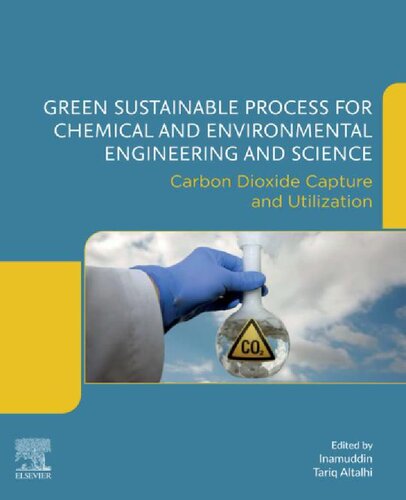
Product details:
ISBN-10 : 0323994309
ISBN-13 : 9780323994309
Author: Dr. Inamuddin, Tariq Altalhi
Green Sustainable Process for Chemical and Environmental Engineering and Science: Carbon Dioxide Capture and Utilization explores advanced technologies based on CO2 utilization. The book provides an overview on the conversion and utilization of CO2, extraction techniques, heterogeneous catalysis, green solvent, industrial approaches, and commodity products through energy-intensive processes. In addition, it highlights lifecycle assessment and biological and engineering strategies for CO2 utilization. Each chapter presents challenges in the processes and future perspectives for the application of CO2 conversion and utilization.
Green Sustainable Process for Chemical and Environmental Engineering and Science: Carbon Dioxide Capture and Utilization 1st Table of contents:
Chapter 1 Carbon dioxide capture and its utilization towards efficient biofuels production
1.1 Introduction
1.2 Utilization of captured carbon dioxide for biofuel production
1.3 Conclusion and future perspectives
References
Chapter 2 Deep eutectic liquids for carbon capturing and fixation
2.1 Carbon dioxide emissions
2.2 Deep eutectic liquids
2.3 Types of deep eutectic liquids
2.4 Preparation of DELs
2.5 Authentication of DELs
2.6 DEL based CO2 absorption
2.7 Carbon capture efficiency of various HBDs
2.8 CO2 absorption in aqueous solution of DELs
2.9 CO2 absorption in ternary DELs
2.10 Ammonium-Based DELs
2.11 Phosphonium based DELs
2.12 Azole based DELs
2.13 Bio-phenol derived superbase based DELs
2.14 Hydrophobic DELs
2.15 Non-ionic DELs
2.16 DEL supported membranes
2.17 DELs with multiple sites interaction
2.18 Conclusion and future prospects
Acknowledgment
References
Chapter 3 Cookstoves for biochar production and carbon capture
3.1 Introduction
3.2 Cookstoves designed for biochar production
3.3 Biochar production and climate-change implications
3.4 Conclusion
References
Chapter 4 Metal support interaction for electrochemical valorization of CO2
List of Abbreviations
4.1 Introduction
4.2 Metal supports for ECR of CO2
4.3 Conclusion
Acknowledgment
References
Chapter 5 Utilization of carbon dioxide as a building block in synthesis of active pharmaceutical ingredients
5.1 Introduction
5.2 N─Nucleophile-triggered CO2-incorporated carboxylation to form C–N bonds
5.3 N─Nucleophile-triggered CO2-incorporated methylation to form C–N bonds
5.4 O─Nucleophile-triggered CO2-incorporated carboxylation to form C–O bonds
5.5 CO2-catalyzed oxidation of alcohols to form C–O bonds
5.6 C-Nucleophile-triggered CO2-incorporated reductive carboxylation to form C–C bonds
5.7 C-nucleophile-triggered CO2-incorporated direct C–H carboxylation to form C–C bond
5.8 C-nucleophile-triggered CO2-incorporated organozinc-mediated carboxylation to form C–C bonds
5.9 C-nucleophile-triggered CO2-incorporated organolithium-mediated carboxylation to form a C–C bond
5.10 C-Nucleophile-triggered CO2-incorporated organomagnesium-mediated carboxylation to form a C–C bond
5.11 Conclusion
References
Chapter 6 Electrochemical Carbon Dioxide Detection
6.1 Introduction
6.2 Capture technologies of CO2
6.3 Fundamentals of electrochemistry
6.4 Direct potentiometric methods
6.5 Summary and conclusion
References
Chapter 7 Carbon dioxide injection for enhanced oil recovery and underground storage to reduce greenhouse gas
7.1 Introduction
7.2 Oil recovery using CO2
7.3 Underground storage of CO2 in unconventional reservoirs
7.4 Current status, challenges and future directions
7.5 Conclusions
Acknowledgment
References
Chapter 8 Ionic liquids as potential materials for carbon dioxide capture and utilization
List of Abbreviations
8.1 Introduction
8.2 Types of ILs
8.3 Future applications of IL and GR-based IL
8.4 Conclusion
References
Chapter 9 Recent advances in carbon dioxide utilization as renewable energy
9.1 Introduction
9.2 CO2 utilization technologies
9.3 Developments in worldwide CO2 utilization projects
9.4 Market scale and value
9.5 Regulation and policy
9.6 Conclusion and future prospects
References
Chapter 10 Metal Organic Frameworks as an Efficient Method for Carbon dioxide capture
10.1 Introduction
10.2 Metal organic framework (MOF)
10.3 Synthesis of some MOFS
10.4 Properties of MOFs
10.5 CO2 capture using MOF
10.6 Adsorption of carbon dioxide in metal organic frameworks
10.7 Methods to enhance CO2 adsorption
10.8 Methods to enhance MOF stability
10.9 Conclusion
References
Chapter 11 Industrial carbon dioxide capture and utilization
11.1 Introduction
11.2 CO2 collection systems based on liquid
11.3 CO2 capturing with ionic liquid solvents
11.4 Applications, implementation and challenges
11.5 Solid CO2 adsorbents for low-temperature applications
11.6 Carbon adsorbents
11.7 Zeolite adsorbents
11.8 Adsorbents of the MOF (metal–organic framework) type
11.9 Adsorbents predicated on carbonate-based alkalis
11.10 Layered double hydroxides (LDHs)-based adsorbents
11.11 Adsorbents made of magnesium oxide (MgO)
11.12 Solid CO2 sorbents for high-temperature applications
11.13 Pre-combustion applications, implementation and problems
11.14 The utilisation of CO2 in industrial processes
11.5 Conclusions and prospects
References
Chapter 12 Ionic liquids for carbon capturing and storage
12.1 Introduction
12.2 CO2 capture technologies
12.3 Ionic liquids (ILs)
12.4 Features of ILs
12.5 IL as absorbents for CO2 capture
12.6 IL hybrids as adsorbents for CO2 capture
12.7 IL hybrids with membranes for CO2 capture
12.8 Ionic liquid supported membrane
12.9 Poly ILs membrane
12.10 Composite membranes
12.11 Conclusion and future insights
References
Chapter 13 Advances in utilization of carbon-dioxide for food preservation and storage
13.1 Introduction
13.2 Utilization of carbon-dioxide in food preservation
13.3 Utilization of carbon-dioxide in food storage
13.4 Prospects and conclusion
References
Chapter 14 An insight into the recent developments in membrane-based carbon dioxide capture and utilization
14.1 Introduction
14.2 Carbon dioxide capture technologies
14.3 A brief about membrane technology
14.4 CO2 separation using membranes
14.5 CO2 utilization using membranes
14.6 Conclusions
References
Chapter 15 Carbon dioxide to fuel using solar energy
15.1 Introduction
15.2 CO2 reduction onto semiconductor surface
15.3 Major bottleneck for CO2 reduction
15.4 Different types of photo catalyst
15.5 Reduction of CO2 to methanol using Cu2O as photo catalyst
15.6 Reduction of CO2 to methanol using Cu2O as electro catalyst
15.7 Benefits of using RGOin the composite catalyst
15.8 Conclusions
Acknowledgment
References
Chapter 16 Adsorbents for carbon capture
16.1 Introduction
16.2 Carbon capture processes
16.3 Adsorbents for CO2 capture
16.4 Future perspective and conclusion
References
Chapter 17 Carbon dioxide capture and utilization in ionic liquids
17.1 Introduction
17.2 Capture of CO2 in ILs
17.3 Electroreduction of CO2 in ILs
17.4 Conclusions
Acknowledgments
References
Chapter 18 Hydrothermal carbonization of sewage sludge for carbon negative energy production
18.1 Introduction
18.2 Sludge as a potential source of alternate energy
18.3 Hydrothermal (HT) treatments for the production of fuel
18.4 Hydrothermal carbonization + gasification + ccs
18.5 Conclusion
Acknowledgement
References
Chapter 19 Utilization of supercritical CO2 for drying and production of starch and cellulose aerogels
19.1 Introduction
19.2 CO2 application — Supercritical drying
19.3 Starch aerogel and CO2 utilization
19.4 Cellulose aerogels and CO2 utilization
19.5 Conclusions
Author contributions
Ethical approval
Declaration of competing interest
Acknowledgment
References
Chapter 20 Advances in carbon bio-sequestration
20.1 Introduction
20.2 Carbon sequestration methods
20.3 Limitations of carbon sequestration methods
20.4 Overview of biological sequestration (Cycle/Mechanism)
20.5 Bioresources for carbon bio-sequestration
20.6 Cyanobacteria
20.7 Microalgae
20.8 Plants
20.9 Bacteria
20.10 Nanomaterials in carbon sequestration
20.11 Future perspectives
20.12 Conclusion
References
Chapter 21 Photosynthetic cell factories, a new paradigm for carbon dioxide (CO2) valorization
21.1 Introduction
21.2 Carbon capture, utilization and storage mechanism
21.3 Biological mechanism of carbon capture
21.4 Products from CCU
21.5 Challenges and opportunities
21.6 Future perspectives and conclusions
Funding information
References
Chapter 22 Carbon dioxide capture and sequestration technologies – current perspective, challenges and prospects
22.1 Introduction
22.2 Carbon capture and sequestration (CCS) technologies
22.3 CO2 transportation, storage and opportunities/applications for CCS technologies
22.4 Current perspective and policies of CSS technologies in various countries throughout the world
22.5 Challenges and socio-economic implications of CCS technologies
22.6 Applications and opportunities for CCS techniques
22.7 Prospects and future work considerations for CCS approaches
22.8 Conclusion
References
Chapter 23 Microbial carbon dioxide fixation for the production of biopolymers
23.1 Introduction
23.2 Sources of CO2 emission
23.3 Sequestration methods of CO2
23.4 Carbon concentrating mechanisms
23.5 Advancements in carbon capture and storage & carbon capture utilization
23.6 Carbon dioxide fixation pathways
23.7 Factors affecting the carbon dioxide biofixation
23.8 Production of biopolymers/bioplastics
23.9 Conclusion
References
Chapter 24 Carbon dioxide capture and its enhanced utilization using microalgae
24.1 Introduction
24.2 Photosynthesis and CO2 fixation using microalgae
24.3 Cultivation systems for carbon dioxide capture by microalgae
24.4 CO2 capture improvement strategies
24.5 Conclusion
References
Chapter 25 Supported single-atom catalysts in carbon dioxide electrochemical activation and reduction
25.1 Introduction
25.2 CO2ERR products
25.3 Single-Atom catalysts efficiency descriptors
25.4 Single-Atom catalyst supports
25.5 Mechanisms for CO2ERR on single-atom catalysts
25.6 Conclusion
References
Chapter 26 Organic matter and mineralogical acumens in CO2 sequestration
Abbreviations
26.1 Overview
26.2 Introduction
26.3 Geo-sequestration
26.4 Bio-sequestration
26.5 Mechanisms of carbon capture
26.6 Transport of carbon dioxide
26.7 Mechanism of carbon accommodation
26.8 Carbon dioxide sequestration in organic matter
26.9 Mineralogical acumen of carbon sequestration
26.10 A note on CO2 disposal in basalt formations
26.11 Summary
People also search for Green Sustainable Process for Chemical and Environmental Engineering and Science: Carbon Dioxide Capture and Utilization 1st:
what is green sustainability
green chemistry program
green chemical principles
green chemical synthesis
green chemical
Tags: Sustainable Process, Chemical, Environmental Engineering, Science, Carbon Dioxide, Utilization, Inamuddin, Tariq Altalhi
You may also like…
Engineering - Environmental
Technique - Nanotechnology


